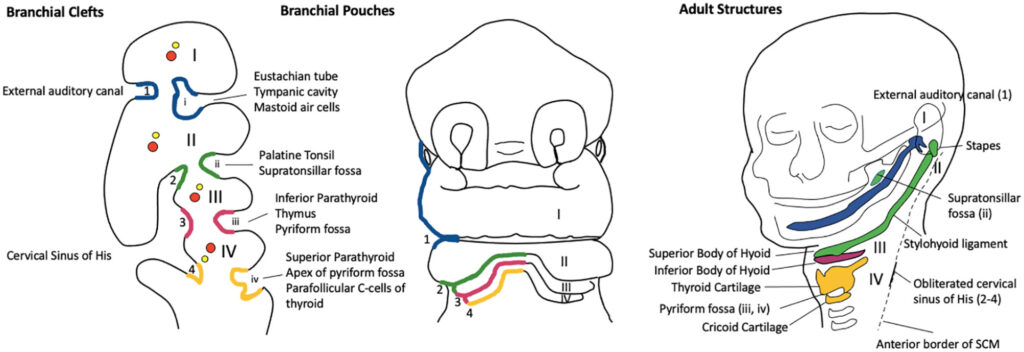Have you ever noticed a lump on your neck that seems to come and go? If so, you may be dealing with a branchial cleft cyst. These cysts are actually quite commonly seen by ENT doctors and can occur when the tissues in the neck develop incorrectly.
To see a surgery done on branchial cleft cysts, head down to the bottom of this page.
Let's start with a little embryology lesson.
Figure 1.
This is a diagram from a Sagepub journal about the embryology of the neck showing the branchial arches

When you were a baby in your mother’s womb, you looked like a tadpole with “gills”. These gills, technically known as branchial arches, are structures that form in the neck and collarbone region. They give rise to various tissues and organs, including the ears, nose, throat, and neck muscles. Sometimes, these arches don’t develop and close off properly, leading to the formation of cysts.
So, what exactly is a branchial cleft cyst?
A branchial cleft cyst is essentially a fluid-filled sac that forms on the side of the neck. There are 4 types, depending on their location but the most common one occurs on the upper side of the neck, usually under the SCM or the large muscle in your neck. Sometimes the error in fetal development may result in fistulas, creating a connection or tract between the throat and the skin of the neck.
What are the symptoms of branchial cleft cysts?
Most branchial cleft cysts are painless lumps in the neck, while others may cause discomfort, and they may appear and disappear over time. In some cases, the cyst can become infected, leading to redness, swelling, and tenderness in the area. Sometimes the infection may lead to pus formation forming within the cyst. In rare cases, the cyst can also cause difficulty swallowing or breathing.
Surgery for branchial cleft cyst
Surgery for a branchial cleft cyst is usually a fairly straightforward procedure done by a head and neck surgeon. The cyst is removed under general anesthesia, and the incision is closed with sutures. In most cases, the recovery time is minimal, and patients can return to their normal activities within a few days.
However, like any surgery, there are potential complications to be aware of. These can include bleeding, infection, and damage to nearby structures like nerves and blood vessels. That’s why it’s so important to choose an experienced ENT doctor who can minimize these risks and ensure a successful outcome.
Watch Dr Ruth Estimar perform an excision of a branchial cleft cyst.
In conclusion, branchial cleft cysts are a common condition that can be caused by developmental abnormalities in the neck region. If you’re dealing with a cyst that won’t go away, see an ENT doctor for diagnosis and treatment. Early detection and treatment are key to preventing complications.
Experience expert ENT surgical care best tailored to your needs.
Book now to schedule your appointment with a skilled ENT surgeon near you and take the first step towards a healthier you.
Your well-being is our top priority.

